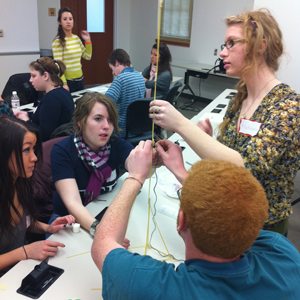Apple features Miami Innovation Course

During the spring of 2011, Peg Faimon, lead faculty in graphic design, led a team of faculty from the Miami Design Collaborative in the creation of a new course entitled CFA111: Innovation, Creativity & Design Thinking. The other faculty came from Architecture, Interior Design, Engineering, Interactive Media Studies and Marketing, and the 80 students that enrolled represented all the divisions of the university, including Education, Business, Humanities, Sciences, Fine Arts, and Engineering.
During the same semester, we received a grant from Apple to be part of their pilot program to implement “Challenge-based Learning (CBL)” in curricula at the university level. There were 16 international educational institutions selected for the pilot, four at the elementary level, four at the middle school level, four at the high school level, and four universities. At Miami, the CBL project was implemented in CFA111 with a small group of 16 honors students in the class.
Miami had the additional honor of being selected as one of the four “case studies” to be featured in the final report on the pilot project. An excerpt, authored by the New Media Corsortium, is below:
The challenge that Miami University chose — “Make undergraduate education relevant!” — correlates with the overarching philosophy of challenge based learning to create learning experiences that transcend the boundaries of current, traditional education. The opportunity to see how students closest to entering the real world embraced the project is extremely valuable insight for advancing CBL. At the same time, the participating students here can be perceived as at a disadvantage compared to
other cases; the K-12 years are much more formative, whereas students in higher education may be too
accustomed to specific methods of learning.“At first the students seemed to be…floating a little,” shared Professor Peg Faimon at the beginning of CBL implementation. “I think some of the students in this class that we’re teaching are used to a little bit more of a free form approach, a little less structure, a little more self-initiative, but some of them aren’t. So, I think they’re starting to get their legs under them in terms of feeling like they have a little more personal direction and ownership of the problem.” As the project progressed, it became increasingly clear that positive group dynamics motivated everyone to succeed.
“I feel that each of us are positively benefiting the project,” said one student. “There is no single strong leader at this point, and we switch off in that role. I am making a difference in the group based on my technological skills and ideas.”
As an added dimension to the challenge, the participating students were a hybrid of both regular and honor students from different disciplines and backgrounds, though that did not prove to be a hindrance. “Everyone is participating in their own way,” a student asserted. “We each bring something different to the table with our different background and talents.” In general, the students took a research-intensive approach to solving the challenge, interviewing college graduates at various stages in their careers, deploying student and faculty surveys, and finding engaging activities at other universities — even those online. The understanding was that the necessary change could only take place once the students were truly engaged in learning other peoples’ and institutions’ educational goals, as well as their perceptions of their learning experiences.
Laying the groundwork for implementing solutions may not have posed too many roadblocks for the students, but implementing solutions proved to be more challenging. “We have generated a lot of good ideas,” said a student. “However, it is difficult to feasibly implement many of these good ideas.” Perhaps one of the most important benefits was that the experience of challenge based learning itself countered some of the disenchantment of traditional learning. “I do enjoy working on projects because they are extremely fulfilling when you have a finished project or have accomplished a goal,” one student opined. “The fact that they require a deliberate effort over a more extended period of time than studying a few days in advance for a test, I feel much more accomplished after putting in the large amount of effort. Working for an end result is something that really motivates me.”
The use of 21st century tools helped maintain this level of engagement throughout the project. Students learned and utilized a wide variety of tools on MacBook and MacBook Pro computers, including iMovie, GarageBand, InDesign, and Illustrator. In using this technology, students experimented in creative ways. “Several of the teams created printed materials as part of the solutions to the challenge,” Faimon recounted. “One team created a visual mapping system to show how liberal education classes relate to one another. Another team created a brochure that identified different aspects of the many student organizations on campus. Another team created a promo piece for the Career Services Office.”

